 Suspended Animation #322
Suspended Animation #322
Having known animation legend Bob Clampett and interviewed him several times, I can state that he always held Walt Disney in high esteem and used him as a business model in creating his own brand.
He told me that was why those “Beany and Cecil” animated cartoons had the song “A Bob Clampett CartooooOOOooon!” and a caricature of him so that people would associate those cartoons with Bob just as people associated Walt with Mickey and the gang.
Interestingly, there are several connections between Bob Clampett and Walt Disney.
Clampett was born in San Diego, California on May 8, 1913 and his early life was influenced by newspaper comic strips and movies featuring Harold Lloyd, Lon Chaney, Douglas Fairbanks and similar classic actors.
 Officially, Bob began his professional career as an animator on the very first Merrie Melodies animated short made by Harman and Ising in 1931 for Warner Brothers, Lady Play Your Mandolin.
Officially, Bob began his professional career as an animator on the very first Merrie Melodies animated short made by Harman and Ising in 1931 for Warner Brothers, Lady Play Your Mandolin.
For a time, he was teamed with the even more legendary Tex Avery on the Looney Tunes animated shorts and my good friend and animation historian Jerry Beck once said that Clampett was the one who “put ‘looney’ in Looney Tunes”.
In September 1978 I got to sit with Clampett for hours in his Seward Street studio recording an interview for the fanzine Mindrot of some of his more outrageous stories about working at Warners and his Beany and Cecil shows.
However, for those who knew Bob, it was quite easy during a conversation for him to drift off onto other subjects that interested him or were sparked by the discussion. During that interview, he shared some of his connections with Walt Disney.
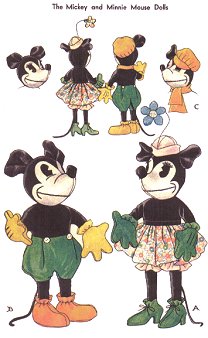 In January 1930, Carolyn “Charlotte” Clark had an idea of how to use her sewing talents to make some money during the Great Depression. She had been making a living selling cookies and novelties.
In January 1930, Carolyn “Charlotte” Clark had an idea of how to use her sewing talents to make some money during the Great Depression. She had been making a living selling cookies and novelties.
She sent teenage nephew, Bob Clampett, to the Alex Theater in Glendale, California.
The young teen sat through three consecutive full showings that day in order to see a Mickey Mouse short several times so he could sketch Mickey Mouse. There were no illustrations of Mickey Mouse available at that time other than on an occasional movie poster because the flood of Mickey Mouse merchandise had not yet started to provide some reference images.
In the dark with his sketchbook and pencil, he had to sit through the newsreel, featurette, main feature and other material just to see the cartoon again and again.
From those sketches, Clark made the first stuffed Mickey Mouse doll. Clampett’s father advised her to get Walt Disney’s permission before she started making and selling them.
He drove her to the Disney Studio. Both Walt and Roy loved the doll. They rented a house near their Hyperion Studio that was later nicknamed the “Doll House” for Clark to work on making the doll in three different sizes. Clark hired some seamstresses to help and the work began.
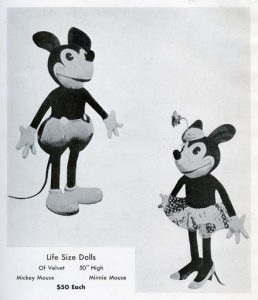 Young Bob Clampett earned thirty cents per doll stuffing each one with kapok and brushing off the excess. Clampett’s father became the head salesman.
Young Bob Clampett earned thirty cents per doll stuffing each one with kapok and brushing off the excess. Clampett’s father became the head salesman.
Originally, the dolls were purchased by Walt and Roy to give to friends, business acquaintances, and special visitors to the studio and to be used for publicity photos.
“Walt Disney himself sometimes came over in an old car to pick up the dolls,” Clampett recalled. “One time, his car loaded with Mickeys wouldn’t start, and I pushed while Walt steered until it caught and he took off.”
After a photo of Walt with one of the dolls appeared in the Screen Play Secrets magazine in 1930 and several newspapers, the demand for owning one of the figures by the general public became overwhelming. Stores were swamped with calls from customers wanting a doll just like the one they saw in the photos.
By November 1930, Clark was producing three to four hundred dolls a week to be sold at two large Los Angeles area department stores, May Company and Bullock’s for five dollars each. The department stores only paid two dollars and fifty cents per doll so made an amazing profit. Clark had to employ six full time seamstresses to meet this goal.
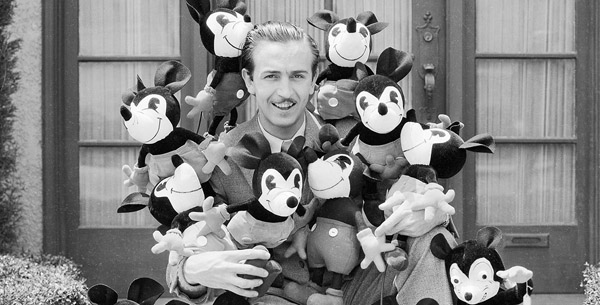
Clampett moved on after his high school graduation to pursue a career as an animator. His distinctive exaggerated style was loved by audiences. Soon, he was promoted to the role of director where among other things, he designed characters, directed voice recording sessions, wrote songs, helped develop the storyboard, assigned animators (like actors) to particular characters or sections and then supervised their work.
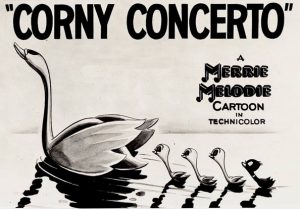 At Warners, Clampett was responsible for two short cartoons that parodied Disney feature films.
At Warners, Clampett was responsible for two short cartoons that parodied Disney feature films.
The first one was Corny Concerto (1943) that parodied Disney’s Fantasia (1940). Clampett replaced distinguished musicologist Deems Taylor with an unshaven and ill-attired Elmer Fudd who introduced two segments. Clampett enjoyed puncturing the pomposity of Taylor in the original movie with the dishelved Fudd.
One segment featured Bugs Bunny and Porky Pig in a woodland setting set to the music of Tales of the Vienna Woods. Porky, accompanied by his hunting dog, are hunting Bugs and all three are finally shot by a squirrel. While Porky and the dog mourn a supposedly dead Bugs Bunny, they pull aside Bugs’s hands from his expected wound, and it is revealed that Bugs is wearing a brassiere and is very much alive.
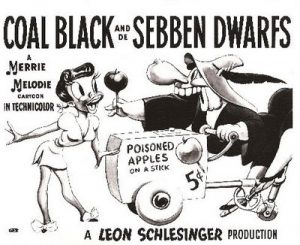 The other segment set to the music of Blue Danube features a young Daffy Duck playing an ugly black duckling joining a flock of white swans. The mother swan does everything she can to get rid of the little black duck but when her babies are taken by a vulture, Daffy goes to the rescue and is eventually accepted as a member of the family.
The other segment set to the music of Blue Danube features a young Daffy Duck playing an ugly black duckling joining a flock of white swans. The mother swan does everything she can to get rid of the little black duck but when her babies are taken by a vulture, Daffy goes to the rescue and is eventually accepted as a member of the family.
This segment also referenced a similar sequence in Fantasia that featured a little black pegasus character trying to be accepted by a family flock. Of course, the Disney version did not feature violent confrontations like the Warners version but was much more pastoral.
The other parody was the notorious Coal Black and De Sebben Dwarfs (1943) that was a modern parody retelling of the Disney version of the timeless classic of Snow White and the Seven Dwarfs but with black caricatures.
Next week I will take a look at that cartoon short and the Beany and Cecil parody of “The Happiest Place on Earth”.


 Jim Korkis is an internationally respected animation historian who in recent years has devoted his attention to the many worlds of Disney. He was a columnist for a variety of animation magazines. With his former writing partner, John Cawley, he authored several animation related books including The Encyclopedia of Cartoon Superstars, How to Create Animation, Cartoon Confidential and Get Animated’s Animation Art Buyer’s Guide. He taught animation classes at the Disney Institute in Florida as well as instructing classes on acting and animation history for Disney Feature Animation: Florida.
Jim Korkis is an internationally respected animation historian who in recent years has devoted his attention to the many worlds of Disney. He was a columnist for a variety of animation magazines. With his former writing partner, John Cawley, he authored several animation related books including The Encyclopedia of Cartoon Superstars, How to Create Animation, Cartoon Confidential and Get Animated’s Animation Art Buyer’s Guide. He taught animation classes at the Disney Institute in Florida as well as instructing classes on acting and animation history for Disney Feature Animation: Florida.




















































Next stop: “Beanyland”!
Did Clampett have any further personal encounters with Walt Disney after he had become a successful cartoonist?
Yes, when the Beany and Cecil puppet show was hugely popular. I will be sharing Bob’s memories of that meeting next week.
Good, I look forward to it!
You would think so, wouldn’t you? I’m sure Disney must have made SOME comment after CORNY CONCERTO and COAL BLACK was released – maybe a letter to Clampett?
You would think so but to the best of my research, Walt kept his opinions of those two cartoons to himself. No animators I have interviewed mentioned either cartoon. However, we know that Walt did screen Warners cartoons for his animators to discuss and dissect. When Friz Freleng’s name came on the screen as a director as I.P. Freleng, Walt would always joke: “Look, it’s I pee freely!” Walt and Friz had a contentious relationship for decades.
This must have been contributed to Chuck Jones resentment towards Clampett.
Disney was Jones’ idol.
Well, if Chuck was resentful of anything, it was Bob’s habit of taking credit for everything short of inventing the pencil and paper.
Ancient enough to remember the Beany and Cecil merchandising blitz: Beaniecopters, puppets, dolls, disguise kits (featured in the cartoons), a Jumping DJ game, cards, and probably more I’m forgetting, with lots of commercial support. There was also a write-up with color pictures in Jack and Jill Magazine, as if it were a movie. It seemed like a pretty big push for a single Saturday morning show.
Also remember that it was originally a successor to a Harveytoon show sponsored by Mattel Toys, which had mascot Matty Mattel in the opening titles and bumpers. I had a talking Matty Mattel doll which, aside from crown and striped shirt, didn’t look like the animated version.
I’ve read about Clampett’s early connection to Disney but I’ve never seen anyone ask him why he never worked for Disney. There he was, a young guy looking for a job in animation and he already had a connection that one would think would get him at least a tryout with the top animation outfit in the country. Did Clampett ever talk about why he went to Warner’s instead of Disney?
Yeah, what a different world we would have if he had!
The story I read was that Walt did offer Bob an animation job, but could only start him after the Hyperion Studio was completed. Then Warners’ came in with an offer, and Bob went them.
I’ve never considered the little duck in Blue Danube to be Daffy. Does anyone know for sure if that was the intent (a name on a model sheet, etc)?
Imagine what Walt must have thought of Dishonest John’s DismalLand.
Incidentally, the late former mayor of Los Angeles, Tom Bradley, who was Black, once said that COAL BLACK was one of his favorite cartoons. And Bradley was no Uncle Tom.
Really enjoyed this post and comments. I had no idea of the original stuffed Mickey and Minnies and Clampetts involvement with them. I so love Clampett. I still believe however that the black duck in Blue Danube is not Daffy.